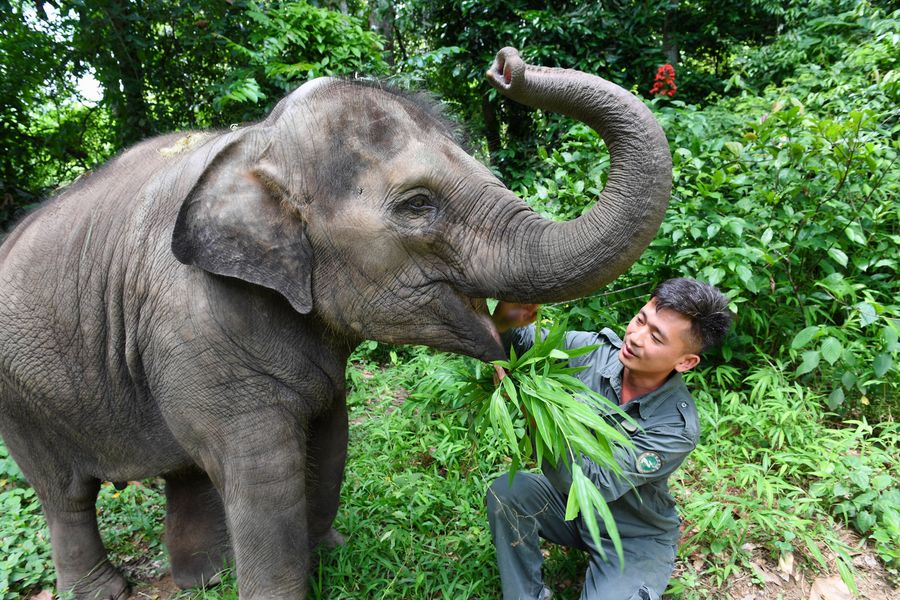
GEP, a Green Alternative to GDP, Is Gaining Ground in China
Yuan Ye / Sixth Tone
(April 12, 2021) — In China, government decisions have long been based on how much a certain project or policy would help increase gross domestic product, or GDP, a measure of economic activity. This approach brought China its development miracle, and also plenty of environmental tragedies.
But GDP’s prominence seems to be slipping.
Not only did China’s most recent five-year plan, published in March, omit the usual annual average GDP growth target, but local governments are also experimenting with a new, greener measurement of development called “Gross Ecosystem Product,” or GEP. By putting a value on all the goods and services produced by ecosystems, it aims to incentivize officials to improve, rather than ignore, the environment.
On March 23, Shenzhen, in southern China’s Guangdong province, claimed it had established the country’s first complete account system for GEP. After six years of pilot work and investigation, Shenzhen “figured out all of the city’s ecological endowments” using techniques that put the tech hub “at the forefront” of GEP, Zhang Yali, deputy chief of the Shenzhen Municipal Ecology and Environment Bureau, said at the press conference.
The city calculates GEP according to three major categories: ecosystem goods and services that can be marketed, such as agriculture and fishery products; nonmarketable services such as forests mitigating climate change by sequestering carbon; and “cultural and touristic benefits,” including improving public health.
Data for these categories are collected with remote-sensing monitoring, surveys, and statistical reports, and are then given a certain weight to arrive at a final number for the entire city. Shenzhen will publish its first annual GEP figure by July 2022. The city’s goal is to grow GDP while not shrinking GEP, said Yu Jing, deputy director of the Shenzhen Development and Reform Commission.
Other cities including Lishui in eastern China’s Zhejiang province and Pu’er in Yunnan province, in the country’s southwest, have also been working with nonprofits and scientists to establish GEP measurement systems. Some local governments have shown strong interest in putting a value on ecosystem services and incorporating this into decision-making, said Lu Shanlong, an associate professor of wetland ecology at the Chinese Academy of Sciences and science head at the China Biodiversity Conservation and Green Development Foundation, a nonprofit organization that has been running regional GEP pilots since 2015.
Shenzhen, designated a “demonstration area of socialism,” has the explicit task of pioneering progressive policies, and city officials have vowed to provide an “applicable and replicable” experience for the whole country. If Shenzhen can show that GEP is a useful tool, it could pave the way for other cities to adopt similar systems in the future, Lu told Sixth Tone, adding that a national GEP standard is in the works and should be released soon.

Green GDP
GEP is not a new concept, but it has long been confined to the world of academia. “China is the first one, as far as I know, taking this particular approach,” said Robert Costanza, an ecological economist at Australian National University who co-authored the 1997 scientific paper that first calculated the GEP of the Earth’s entire biosphere, at that time estimated to be between $16 trillion and $54 trillion per year. “It was a very conservative estimate,” Constanza told Sixth Tone.
There’s growing interest around the world in alternatives to GDP, Costanza said, as more people have come to realize the limitations of the almost-1oo-year-old metric. “It leaves out many important things that are not marketed,” such as household labor, he said. It also doesn’t account for income inequality. One alternative is the United Nations’ System of Environmental-Economic Accounting, which officials in Shenzhen said they referred to for their GEP system.
In 2004, in an effort to mitigate the effects of rapid urbanization, China’s State Environmental Protection Administration began piloting a metric called Green GDP, which subtracts environmental costs from conventional GDP. But poor implementation, disagreement on how it should be calculated, and a lack of enthusiasm from local governments meant that it disappeared from public debate around 2010.
Environmentally conscious governance has since received renewed endorsement from the top levels of government, however. President Xi Jinping famously said that “clear waters and lush hills are worth a mountain of gold and a mountain of silver.” The quote, colloquially known as “Two Mountains,” has become a mantra for local governments in their pursuit of building an “ecological civilization” — an ideological framework championed by Xi that has been written into China’s constitution.
“Perhaps there is no other idea in the world than GEP that fits the Two Mountain theory more precisely,” said Li Yifei, an assistant professor of environmental studies at New York University Shanghai. GEP can be seen as an evolution of Green GDP, a metric defined around the positive contributions of nature instead of the damage done to it, said Costanza.

Experimental Soil
Despite the confidence of Shenzhen officials, GEP is still far from a mature reflection of the connections between nature and people, experts told Sixth Tone. Its compatibility with complicated realities is untested.
Lu, the wetland ecology professor, said working with the government of Pu’er on its GEP system was smooth. The team from his foundation estimated the annual value of ecosystems in the city and its mostly rural counties at nearly 506 billion yuan ($77 billion) in 2016, with nonmarketable services such as water supply and soil formation accounting for 87%.
Officials were encouraged by the result, said Lu. The city decided to incorporate GEP in the performance reviews of local officials, assigning them the goal of maintaining or growing the GEP of their jurisdictions. But Pu’er may be an exception, Lu said, as it is an area with a particularly rich environment, where local officials were already being evaluated based on how well they protected nature.
The relative weight given to GEP is mostly up to local leaders, Lu said. In Hinggan League, in northern China’s Inner Mongolia region, his team is also working on a GEP pilot. There, the local government doesn’t bother to include GEP in its decision-making but sees the figure more as evidence of local conservation efforts. “It’s like telling others, You should see the value,” Lu said.
Still, any experimenting with GEP is helpful. “They (the pilot cities) are the first ones eating crab,” Lu said, using an idiom for doing something difficult. “It is because of their positive attitude that this measuring system has an experimental soil.” His team has been supported by Ouyang Zhiyun, an ecologist at the Chinese Academy of Sciences who has played a key role in promoting GEP as a policy tool, including in Shenzhen.
Li, the Shanghai scholar, praises such efforts, saying “the transformation is something everyone welcomes.” But he cautions against governments rushing to embrace GEP. Prudence is required to make sure China doesn’t make the same mistakes it did by fixating on GDP, he said, adding: “You can’t just say pretty words because the direction itself is encouraging.”
Environmental processes are complex, Li said, and their value is difficult to capture in concrete areas or time scales. For example, air pollution doesn’t have just one cause or source, and ecosystems like river basins span multiple provinces. If GEP is ever used throughout the country, it will be difficult to determine which environmental benefit should be attributed to which locality.
Growing GEP may not always be in line with local people’s interests, Li cautions. In 2019, when China strengthened protection of its protected areas, thousands of people had to upend their lives, relocating — with compensation — to make way for conservation projects. More such conflicts could arise when officials try to grow their local GEP. Big valuations are at stake: A 2021 paper used GEP to estimate that China’s land-based protected areas were worth $2.64 trillion.
There are also worries about the quality and availability of good data, said Chen Haojie, a Ph.D. student of ecological economics at the Crawford School of Public Policy at Australian National University and author of the 2021 paper. Detailed figures — for example, about the vegetation cover or the carbon sequestration rate of a particular ecosystem — don’t always exist.
Costanza, the ecological economist, is confident such issues can be overcome. “There is no best way, but there is a worst way, and the worst way is not to do it all,” he said.
In August 2019, Beijing unveiled a plan to make Shenzhen the model city for China and the world, which included wide-ranging reforms in the legal, financial, medical and social sectors. Photo: Xinhua
China’s Tech Hub Shenzhen Moves Ahead with GDP Alternative that Measures Value of Ecosystem Goods and Services

He Huifeng / South China Morning Post
GUANGDONG (March 24, 2021) — Gross ecosystem product (GEP) system is the total value of final ecosystem goods and services supplied to human well-being in a region annually. Natural ecosystems such as forests, grasslands, wetlands, deserts, fresh water and oceans, and artificial systems based on natural processes like farmland, pastures, aquaculture farms and urban green land are included.
China’s technology hub of Shenzhen claims to have established the first complete system of accounting that will focus on the contributions made by resources and the environment to the local economy, that could potentially replace traditional gross domestic product (GDP) to define the development of the city.
The introduction of the gross ecosystem product (GEP) system comes as China is looking to play down the importance of its GDP growth rate after Beijing dropped a specific numerical target in its latest five-year plan.
GEP is, according to the International Union for Conservation of Nature, the total value of final ecosystem goods and services supplied to human well-being in a region annually, and can be measured in terms of biophysical value and monetary value. Ecosystems that can be measured include natural ecosystems such as forests, grasslands, wetlands, deserts, fresh water and oceans, and artificial systems that are based on natural processes like farmland, pastures, aquaculture farms and urban green land.
Posted in accordance with Title 17, Section 107, US Code, for noncommercial, educational purposes.